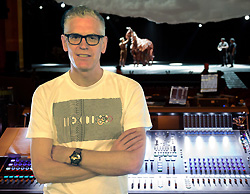
Originally based on Michael Morpurgo’s 1982 children’s novel of the same name, War Horse is not a musical.
It does, however, depend heavily on music as well as on the interplay between pre-recorded sound effects and the sounds made by performers manning the production’s life-sized horse puppets in its depiction of the chaotic battles between man and horses and man and machine during World War I.
“Timing is critical between sound and lighting,” he says. “You need to give viewers the impression things are happening at high speed so you can’t afford to drop the ball. Many of the lighting cues are actually triggered from the soundboard using QLab (Live Show Control).
“That was crucial because explosions often interrupt dialogue and we needed to be able to choreograph the scenes to create something dynamic, but still be able to tell the story.”
Over the course of time, he spends less time behind the console. “I still get back there and interfere occasionally, but I’m working with people that are so skilled and, with the ability to pre-program things now, that’s been taken out of my hands, which allows me more time to focus on the design and manipulation of sound.”
Right Combination
While technology and the quality of sound reproduction has improved by leaps and bounds during his career, Shutt downplays the impact technology has had on his approach. “You can use shabby equipment like cassette players or you can use high-end equipment, but it’s all about ideas, and ideas don’t rely as much on technology as you might think.”
What’s most important in his view are the raw materials provided by the actors, the director and the other technicians and creators he works with. “For me, it’s the people and alchemy between them in terms of making theatre. It’s trying to get the right combination of people in a room.”
Still, he does favor specific equipment: “I love DiGiCo’s SD7 console because of its flexibility and scope and the fact that it really is geared towards live theatre.” He also points to Pro Tools and QLab as ‘go-to’ tools for creating and editing the combination of sounds he draws on during the design process, and adds that many of the recordings he uses, he’s compiled himself.
“I’ve got a vast (sound) library and over time I’ve added more and more to it, from the sound of babbling brooks, to seagulls, to the parties my neighbors have in their back garden – when I can’t get to sleep, because they’re making too much noise, I record them. Also, I live quite close to one of the hot spots where the riots happened last year and there were helicopters just hovering over my area for days on end, so I went out recorded them, and some of that I actually used in Timon of Athens.”
Clearly, even when Shutt does have some rare down time, his job is rarely far from his mind. And when he’s actually in the theatre during pre-production, he says, “You literally have to physically take me out of the building to make me stop working. When I can see the whites of an audience’s eyes, you just can’t drive me away from it.
“That goes back to the Complicite days,” he adds. “The opening night performance was never the final day you worked on something. It’s just the beginning of a long process of adaptation. It’s a live event, isn’t it? Things change.”
Based in Toronto, Kevin Young is a freelance music and tech writer, professional musician and composer.
